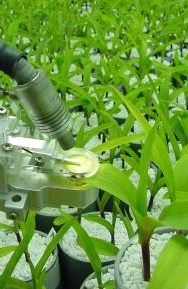| contact
leipner photosynthesis consulting
Dr. Jörg Leipner
Neumattstrasse 2
4450 Sissach
SWITZERLAND
email: leipner@photosynthesis.ch
mobile: +41 78 817 3559
|
Applications
Screening for
chilling tolerance of maize seedlings
|
The possibility of using chlorophyll fluorescence technique as a
selection tool for improving the chilling tolerance of maize was
investigated in six genotypes differing greatly in their chilling
tolerance (Fracheboud
et al., 1999). Upon gradual cooling measurements of the operating
quantum efficiency of PSII photochemistry (Fq'/Fm')
indicated that leaves of tolerant genotypes, that developed at
suboptimal temperature, maintained higher rates of electron
transport than leaves of sensitive genotypes.
Applying the method to flint and dent
breeding population led to a substantial increase (up to 31%) in the
photosynthetic capacity of hybrids between selected F3 inbreeding
families grown at suboptimal temperature, demonstrating that the
method is an efficient selection tool for improving the chilling tolerance
of maize through breeding.
Imbred lines of contrasting chilling tolerance that were developed by
this method were used to investigate the genetic basis of chilling
tolerance under controlled as well as under field conditions by
analyzing quantitative trait loci (QTL) of an F2:3 population (Fracheboud
et al., 2004;
Jompuk et al., 2005;
Leipner et al.,
2008).
Marker and phenotype
assisted backcrossing have successfully improved the chilling tolerance of
experimental lines (PhD
thesis S.K. Biradar) and lines that are used for hybrid production
(business
report 2003/04 of Delley Samen und
Pflanzen AG).
|

Screening maize seedlings for chilling tolerance of photosynthesis |

|
examples
Screening for chilling tolerance of maize
seedlings
[further information]
Discriminating winter wheat for frost
tolerance
[further information]
Detecting ozone damage in Phaseolus
[further information]
|


